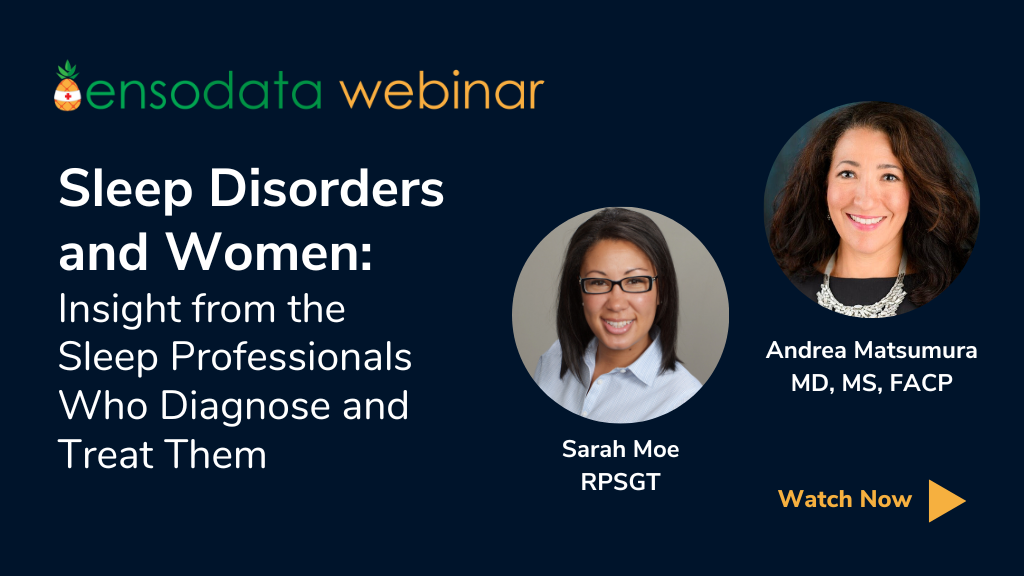21 Tips on How to Raise Awareness around Women’s Sleep Challenges
Women face different sleep challenges than their male counterparts. They are more likely than men to face sleep disorders, in part due to the hormonal changes they go through during menstruation, pregnancy, and menopause. At the same time, they are often less likely to receive the care they need. Much of this disparity in attention and overall underrepresentation stems from a lack of education around sleep, both in general and in relation to women. The underrepresentation of women in sleep medicine was touched on in the recent EnsoData Sleep Disorders and Women webinar. In the webinar, the expert panelists discussed women’s sleep disorders from insomnia to obstructive sleep apnea (OSA). Regarding OSA, one of the themes that arose in the webinar discussion was the differences in the prevalence and the telling symptoms between men and women. While men are more likely to be diagnosed with OSA – in part due to body mass, neck size, and other contributing factors – around 9% of middle-aged women suffer from OSA. And while men are more likely to suffer from OSA, the two genders also present with sleep apnea in different ways. Instead of sleepiness, which men often cite, women tend to report fatigue, headaches or swollen feet upon awakening, insomnia, and frequent awakenings during the night. Furthermore, while women present differently, the changes in their life – including pregnancy and menopause – can also trigger sleep disorders. In fact, the onset of menopause marks the beginning of an increased risk for OSA.“Too often women attribute their difficulties to hormonal changes or to the fact that they are just getting older,” shared Brandon Peters, MD, in Verywell Health.And unfortunately, a missed OSA diagnosis – for anyone, male or female – can lead to serious health problems, including increased risk of heart attack, stroke and early death.
What can we do in sleep medicine?
Well, you’ve probably heard this before: it all starts with education. We can provide education that is focused on information around sleep challenges specific to women, like our Sleep Disorders and Women webinar. During the webinar, we polled the audience and received 97 responses on how to best educate women and healthcare providers about the specific sleep challenges of women, and compiled them into 21 suggestions for bringing more awareness to sleep disorders in women.Here are the 21 Women’s Sleep Education Tips:
- Talk about sleep. Simply being an advocate for sleep is important.
- Screen for women’s sleep with a specifically tailored approach towards symptoms more common in women.
- Explain to women how getting enough sleep will benefit them in many aspects of their life, just like diet and exercise.
- Encourage women to seek help if they exhibit any symptoms of poor sleep and not ignore the signs.
- Remind women that they present differently than men.
- Improve sleep health education opportunities for physicians who care for women to help them recognize how symptoms differ in women.
- Address sleep earlier in medical school, so all physicians understand its importance.
- Motivate primary care PAs and NPs to ask about sleep. If healthcare providers don’t ask, patients will not think to bring up sleep until their symptoms are bad.
- Inspire more technologists to seek a sleep education (CCSH) credential.
- Educate OB/GYN and midwives in sleep so that they know what to screen for and what questions to ask during patient appointments.
- Use technologists with their CCSH as physician extenders in women’s health programs.
- Teach patients about the hormonal changes that women go through and how it might affect sleep patterns.
- Inform women that being sleepy is not a men’s only problem.
- Rewrite the standard sleep questionnaires for women.
- Embed the importance of sleep for women with sleep disorders into commercials, radio, podcasts, conferences, social media, etc.
- Fund TV channels or radio stations dedicated specifically to women’s health.
- Incorporate sleep discussions into gynecology exams.
- Develop tools to help identify and then manage sleep problems associated with women’s sleep health.
- Affirm issues and encourage compliance.
- Participate in local community events and webinars where the discourse audience is women outside of the sleep medicine community.
- Encourage specialists working with women to screen women for sleep issues and start the dialogue.






